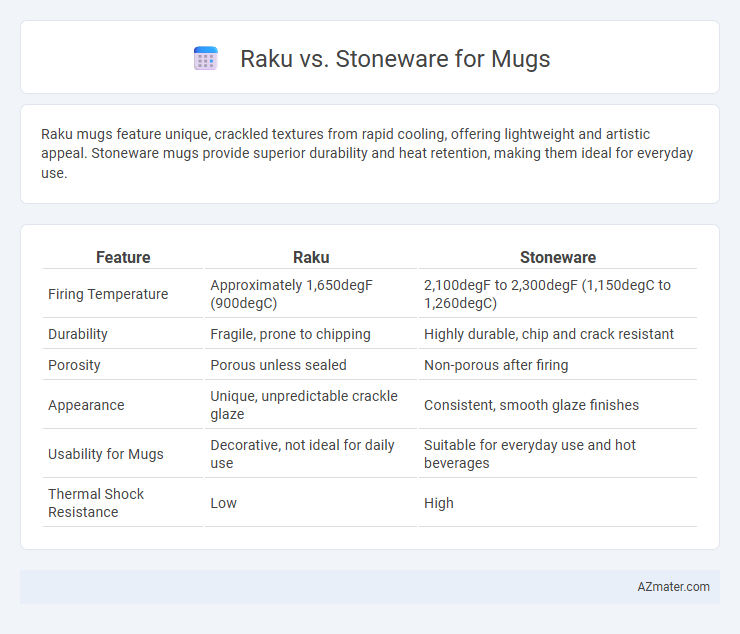Raku mugs feature unique, crackled textures from rapid cooling, offering lightweight and artistic appeal. Stoneware mugs provide superior durability and heat retention, making them ideal for everyday use.
Table of Comparison
| Feature | Raku | Stoneware |
|---|---|---|
| Firing Temperature | Approximately 1,650degF (900degC) | 2,100degF to 2,300degF (1,150degC to 1,260degC) |
| Durability | Fragile, prone to chipping | Highly durable, chip and crack resistant |
| Porosity | Porous unless sealed | Non-porous after firing |
| Appearance | Unique, unpredictable crackle glaze | Consistent, smooth glaze finishes |
| Usability for Mugs | Decorative, not ideal for daily use | Suitable for everyday use and hot beverages |
| Thermal Shock Resistance | Low | High |
Introduction: Raku vs Stoneware for Mug Making
Raku mugs, crafted through a rapid-firing process involving post-firing reduction, showcase unique, crackled glazes and vibrant textures ideal for artistic expression. Stoneware mugs, fired at higher temperatures, offer durability, non-porous surfaces, and excellent thermal retention, making them practical for everyday use. Both materials present distinct aesthetic and functional qualities, influencing artists and consumers based on purpose and design preference.
Overview of Raku Pottery Techniques
Raku pottery techniques involve rapid firing and cooling processes that create unique crackled glazes and metallic finishes, setting it apart from the dense and durable stoneware used in mugs. Raku mugs are often handcrafted with porous surfaces and unpredictable textures, emphasizing artistic expression over functionality. Stoneware mugs offer superior strength, heat retention, and chip resistance, making them ideal for everyday use compared to the fragile and thermally sensitive nature of raku pieces.
Understanding Stoneware: Properties and Methods
Stoneware mugs offer exceptional durability due to their dense, non-porous composition fired at high temperatures between 1,200degC and 1,300degC. This type of ceramic resists chipping and thermal shock, making it ideal for everyday use and dishwasher safety. Glazing methods for stoneware enhance its natural strength and provide a smooth finish that retains heat effectively, distinguishing it from the more fragile, porous Raku ceramics.
Visual Appeal: Comparing Raku and Stoneware Mugs
Raku mugs feature a distinctive, crackled glaze and unpredictable color variations that create a striking, artistic visual appeal. Stoneware mugs boast a smooth, earthy texture with uniform tones, offering a classic and versatile aesthetic. The choice between Raku and Stoneware mugs depends on whether a bold, handcrafted look or a consistent, rustic charm is desired.
Durability and Strength: Raku vs Stoneware Mugs
Stoneware mugs are known for their exceptional durability and strength, making them resistant to chipping, cracking, and thermal shock during everyday use. Raku mugs, while admired for their unique, artistic finishes, tend to be more fragile due to the rapid cooling process that creates microfractures in the clay body. For practical, long-lasting mugs, stoneware offers a superior balance of toughness and heat retention compared to the more delicate and decorative raku ceramics.
Heat Retention and Functionality for Mugs
Raku mugs offer unique thermal properties due to their porous surface, which allows moderate heat retention but can cool beverages faster compared to stoneware. Stoneware mugs, with their dense and vitrified structure, excel in maintaining consistent heat, keeping drinks warm for longer durations. Functionality-wise, stoneware provides greater durability and is often microwave and dishwasher safe, while raku mugs are more fragile and typically recommended for hand washing and occasional use.
Safety, Food Use, and Glaze Considerations
Raku mugs often feature porous surfaces and glaze cracks, which can harbor bacteria and leach metals, making them less ideal for daily food use compared to dense, vitrified stoneware that offers safer, non-porous surfaces resistant to staining and microbial growth. Stoneware is typically fired at higher temperatures, producing durable glazes certified for food safety, while Raku's low-temperature firing and rapid cooling can embed potentially harmful substances in its glaze. Choosing stoneware ensures compliance with FDA food safety standards, whereas Raku mugs should be verified for lead-free, non-toxic glaze formulations before regular consumption.
Artistic Expression: Design Possibilities
Raku mugs offer unique artistic expression through their unpredictable glaze patterns and crackling effects achieved by rapid cooling techniques, creating one-of-a-kind, visually dynamic pieces. Stoneware mugs allow for more controlled and diverse design possibilities with a wide range of glazes, textures, and surface treatments, providing consistent durability suited for everyday use. Artists favor Raku for its spontaneity and dramatic finishes, while Stoneware supports intricate detailing and functional artistry in mug design.
Maintenance and Care Differences
Raku mugs require careful handling due to their porous nature and delicate glaze, often needing gentle hand washing and avoiding prolonged water exposure to prevent cracking. Stoneware mugs offer greater durability and resistance to thermal shock, making them easier to clean and generally dishwasher-safe. Proper maintenance of raku involves avoiding microwave use, while stoneware is typically microwave and oven safe, reflecting their differing firing processes and material compositions.
Choosing the Best Material for Your Perfect Mug
Raku mugs offer unique, crackled finishes with rapid cooling during firing that makes each piece one-of-a-kind, ideal for collectors seeking artistic expression and individuality. Stoneware mugs provide superior durability, heat retention, and non-porous surfaces, making them practical for everyday use and convenient for microwave and dishwasher safety. Selecting between Raku and stoneware depends on whether you prioritize aesthetic uniqueness or functional resilience for your perfect mug.

Infographic: Raku vs Stoneware for Mug
 azmater.com
azmater.com